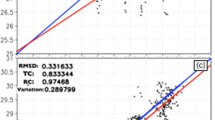Abstract
Satellite-derived sea surface temperature (SST) is validated based on in-situ data from the East China Sea (ECS) and western North Pacific where most typhoons, which make landfall on the Korean peninsula, are formed and pass. While forecasting typhoons in terms of intensity and track, coupled ocean-typhoon models are significantly influenced by initial ocean condition. Potentially, satellite-derived SST is a very useful dataset to obtain initial ocean field because of its wide spatial coverage and high temporal resolution. In this study, satellite-derived SST from various sources such as Tropical Rainfall Measuring Mission Microwave Imager (TMI), Advanced Microwave Scanning Radiometer for Earth Observing System (AMSR-E) and New Generation Sea Surface Temperature for Open Ocean (NGSST-O) datasets from merged SSTs were compared with in-situ observation data using an indirect method which is using near surface temperature for validation of satellite derived SST. In-situ observation data included shipboard measurements such as Expendable Bathythermograph (XBT), and Conductivity, Temperature, Depth (CTD), and Argo buoy data. This study shows that in-situ data can be used for microwave derived SST validation because homogeneous features of seawater prevail at water depths of 2 m to 10 m under favorable wind conditions during the summer season in the East China Sea. As a result of validation, root-mean-square errors (RMSEs) are shown to be 0.55 °C between microwave SST and XBT/CTD data mostly under weak wind conditions, and 0.7 °C between XBT/CTD measurement and NGSST-O data. Microwave SST RMSE of 0.55 °C is a potentially valuable data source for general application. Change of SST before and after typhoon passing may imply strength of ocean mixing due to upwelling and turbulent mixing driven by the typhoon. Based on SST change, ocean mixing, driven by Typhoon Nari, was examined. Satellite-derived SST reveals a significant SST drop around the track immediately following the passing of Typhoon Nari in October, 2007.
Similar content being viewed by others
Reference
Barton IJ (2001) Interpretation of satellite-derived sea surface temperatures. Adv. Space Res 28:165–170
Bhaskar TVS, Rahman SH, Pavan ID, Ravichandran M, Nayak S (2009) Comparison of AMSR-E and TMI Sea surface temperature with Argo near-surface temperature over the Indian Ocean Int J Remote Sens 30(10):2669–2684
Casey K, Cornillon P (1999) A comparison of satellite and insitu-based sea surface temperature climatologies. J Climate 12:1848–1863
Donlon CJ, Nightingale TJ, Sheasby T, Turner J, Robinson IS, Emery WJ (1999) Implications of the Oceanic Thermal Skin Temperature Deviation at High wind speed. Geophys Res Lett 25(16):2505–2508
Donlon CJ, Minnett P, Gentemann C, Nightingale TJ, Barton IJ, Ward B, Murray J (2002) Towards Improved Validation of Satellite Sea Surface Skin Temperature Measurements for Climate Research. J Climate 15:353–369
Donlon CJ, Nykjaer L, Gentemann C (2004) Using sea surface temperature measurements from microwave and infrared satellite measurements. Int J Remote Sens 25(7):1331–1336
Emery WJ, Baldwin DJ (2001) Accuracy of in situ sea surface temperatures used to calibrate infrared satellite measurements. J Geophys Res 106:2387–2405
Emery WJ, Yu Y (1997) Satellite Sea surface temperature patterns. Int J Remote Sens 18(2):323–334
Guan L, Kawamura H (2004) Merging satellite infrared and microwave SSTs: methodology and evaluation of the new SST. J Oceanogr 60:905–912
Hosoda K, Murakami H, Sakaida F, Kawamura H (2007) Algorithm and validation of sea surface temperature observation using MODIS sensors aboard Terra and Aqua in the western North Pacific. J Oceanogr 63:267–280
McKeown W, Bretherton F, Huang HL, Smith WL, Revercomb HL (1995) Sounding the skin of water: sensing air-water interface temperature gradients with interferometry. J Atmos Oceanic Tech 12:1313–1327
Merchant CJ, Harris AR, Murray MJ, Závody AM (1999) Toward the elimination of bias in satellite retrievals of sea surface temperature: 1. theory, modeling and interalgorithm comparison. J Geophys Res 104(C10):23,565–23,578
Mohd ISM, Mohd NMR (2004) Sea Surface Temperature retrieval using TRMM microwave imager satellite data in the South China Sea. In: International Symposium and Exhibition on Geoinformation, Serdang, Selangor, Malaysia, September 2004, pp 21–23
Murray MJ, Allen MR, Merchant CJ, Harris AR, Donlon CJ (2000) Direct observation of skin-bulk SST variability. Geophys Res Lett 27:1,171–1,174
Peng G, Yanchen B (2008) Validation of AVHRR/MODIS/AMSRE Satellite SST Products in the West Tropical Pacific. In: Geoscience and Remote Sensing Symposium, 2008, IGARSS 2008, IEEE International, pp 942–945
Niclòs R, Caselles V, Coll C, Valor E (2007) Determination of sea surface temperature at large observation angles using an angular and emissivity-dependent split-window equation. Remote Sens Environ 111:107–121
Reynolds RW, Rayner NA, Smith TM, Stokes DC, Wang W (2002) An improved in-situ and satellite SST analysis for Climate. J Climate 16:1609–1625
Sakaida F, Kawamura H, Takahashi S, Shimada T, Kawai Y, Hosoda K, Guan L (2009) Research and development of the New Generation Sea Surface Temperature for Open Ocean (NGSST-O) product and its demonstration operation. J Oceanogr 65:859–870
Schluessel P, Emery WJ, Grassl H, Mammen T (1990) On the bulk-skin temperature difference and its impact on satellite remote sensing of sea surface temperature. J Geophys Res 95:13,341–13,356
Stammer D, Wentz F, Gentemann C (2003) Validation of Microwave Sea Surface Temperature Measurements for Climate Purpose. J Climate 16:73–87
The GHRSST-PP International Project Office (2008) GHRSST-PP Product User Guide. http://www.medspiration.org/documents/GHRSST-PP-Product-User-Guide-v1.1.pdf
Wenths FJ, Gatemann C, Smith S, Chelton D (2000) Satellite measurements of sea surface temperature through clouds. Science 288:847–850
Wu CR, Chang YL, Oey LY, Chang CW, Hsin YC (2008) Air-sea interaction between tropical cyclones Nari and Kuroshio. Geophys Res Lett 35:L12605, 1–7
Author information
Authors and Affiliations
Corresponding author
Rights and permissions
About this article
Cite this article
Kim, E.J., Kang, S.K., Jang, ST. et al. Satellite-derived SST validation based on in-situ data during summer in the East China Sea and western North Pacific. Ocean Sci. J. 45, 159–170 (2010). https://doi.org/10.1007/s12601-010-0014-3
Received:
Revised:
Accepted:
Published:
Issue Date:
DOI: https://doi.org/10.1007/s12601-010-0014-3



